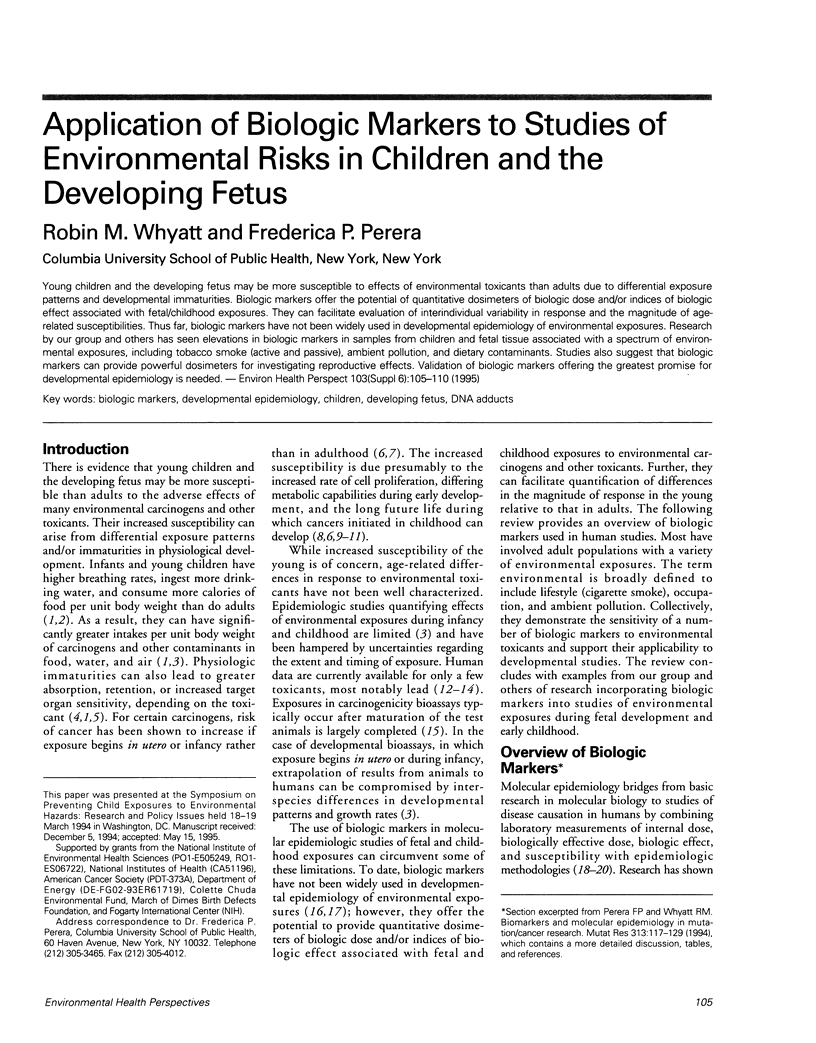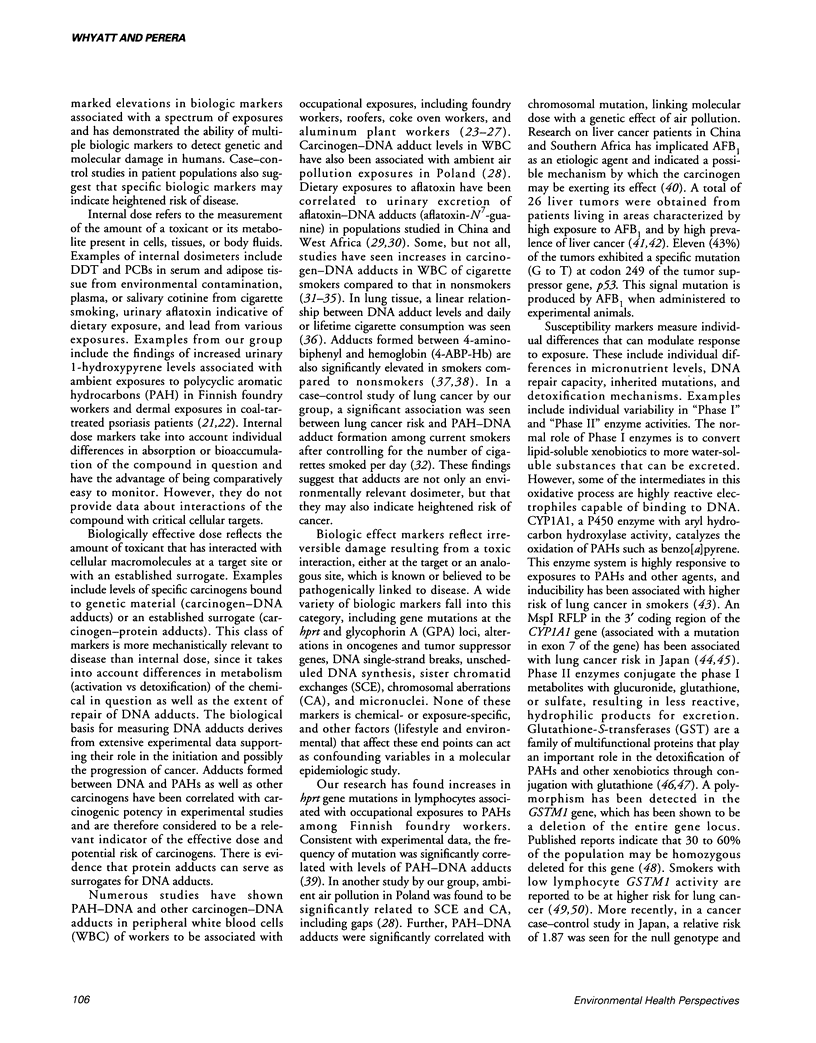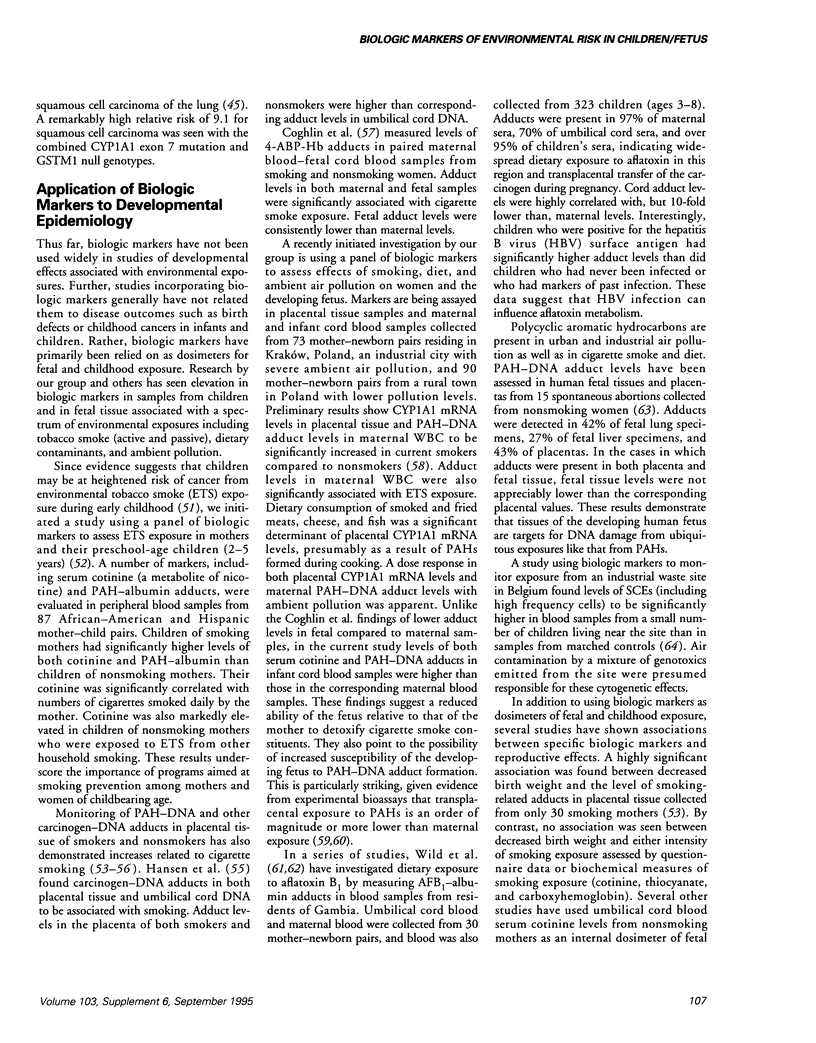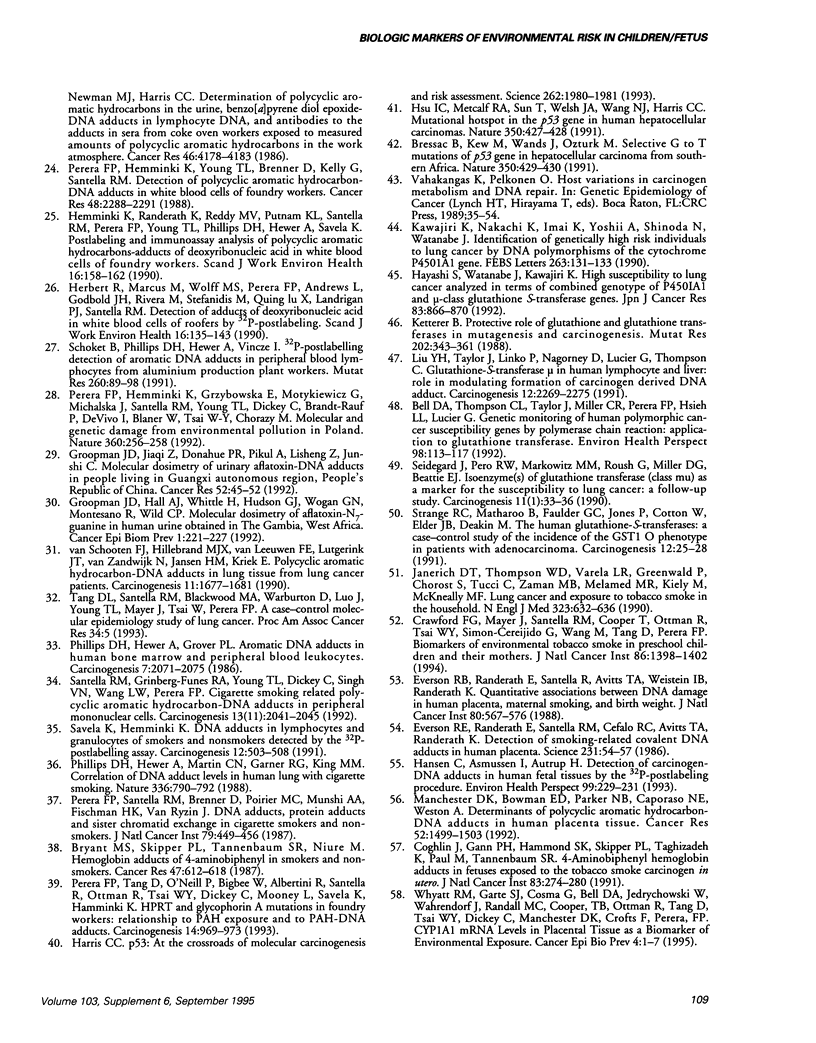Abstract
Young children and the developing fetus may be more susceptible to effects of environmental toxicants than adults due to differential exposure patterns and developmental immaturities. Biologic markers offer the potential of quantitative dosimeters of biologic dose and/or indices of biologic effect associated with fetal/childhood exposures. They can facilitate evaluation of interindividual variability in response and the magnitude of age-related susceptibilities. Thus far, biologic markers have not been widely used in developmental epidemiology of environmental exposures. Research by our group and others has seen elevations in biologic markers in samples from children and fetal tissue associated with a spectrum of environmental exposures, including tobacco smoke (active and passive), ambient pollution, and dietary contaminants. Studies also suggest that biologic markers can provide powerful dosimeters for investigating reproductive effects. Validation of biologic markers offering the greatest promise for developmental epidemiology is needed.
Full text
PDF





Selected References
These references are in PubMed. This may not be the complete list of references from this article.
- Bell D. A., Thompson C. L., Taylor J., Miller C. R., Perera F., Hsieh L. L., Lucier G. W. Genetic monitoring of human polymorphic cancer susceptibility genes by polymerase chain reaction: application to glutathione transferase mu. Environ Health Perspect. 1992 Nov;98:113–117. doi: 10.1289/ehp.9298113. [DOI] [PMC free article] [PubMed] [Google Scholar]
- Bellinger D., Leviton A., Waternaux C., Needleman H., Rabinowitz M. Longitudinal analyses of prenatal and postnatal lead exposure and early cognitive development. N Engl J Med. 1987 Apr 23;316(17):1037–1043. doi: 10.1056/NEJM198704233161701. [DOI] [PubMed] [Google Scholar]
- Bressac B., Kew M., Wands J., Ozturk M. Selective G to T mutations of p53 gene in hepatocellular carcinoma from southern Africa. Nature. 1991 Apr 4;350(6317):429–431. doi: 10.1038/350429a0. [DOI] [PubMed] [Google Scholar]
- Chang M. J., Koestner A., Hart R. W. Interrelationships between cellular proliferation, DNA alkylation and age as determinants of ethylnitrosourea-induced neoplasia. Cancer Lett. 1981 Jun;13(1):39–45. doi: 10.1016/0304-3835(81)90084-7. [DOI] [PubMed] [Google Scholar]
- Coghlin J., Gann P. H., Hammond S. K., Skipper P. L., Taghizadeh K., Paul M., Tannenbaum S. R. 4-Aminobiphenyl hemoglobin adducts in fetuses exposed to the tobacco smoke carcinogen in utero. J Natl Cancer Inst. 1991 Feb 20;83(4):274–280. doi: 10.1093/jnci/83.4.274. [DOI] [PubMed] [Google Scholar]
- Cohen S. M., Ellwein L. B. Genetic errors, cell proliferation, and carcinogenesis. Cancer Res. 1991 Dec 15;51(24):6493–6505. [PubMed] [Google Scholar]
- Crawford F. G., Mayer J., Santella R. M., Cooper T. B., Ottman R., Tsai W. Y., Simon-Cereijido G., Wang M., Tang D., Perera F. P. Biomarkers of environmental tobacco smoke in preschool children and their mothers. J Natl Cancer Inst. 1994 Sep 21;86(18):1398–1402. doi: 10.1093/jnci/86.18.1398. [DOI] [PubMed] [Google Scholar]
- Day N. E., Brown C. C. Multistage models and primary prevention of cancer. J Natl Cancer Inst. 1980 Apr;64(4):977–989. [PubMed] [Google Scholar]
- Drew R. T., Boorman G. A., Haseman J. K., McConnell E. E., Busey W. M., Moore J. A. The effect of age and exposure duration on cancer induction by a known carcinogen in rats, mice, and hamsters. Toxicol Appl Pharmacol. 1983 Mar 30;68(1):120–130. doi: 10.1016/0041-008x(83)90361-7. [DOI] [PubMed] [Google Scholar]
- Dyroff M. C., Richardson F. C., Popp J. A., Bedell M. A., Swenberg J. A. Correlation of O4-ethyldeoxythymidine accumulation, hepatic initiation and hepatocellular carcinoma induction in rats continuously administered diethylnitrosamine. Carcinogenesis. 1986 Feb;7(2):241–246. doi: 10.1093/carcin/7.2.241. [DOI] [PubMed] [Google Scholar]
- Everson R. B., Randerath E., Santella R. M., Avitts T. A., Weinstein I. B., Randerath K. Quantitative associations between DNA damage in human placenta and maternal smoking and birth weight. J Natl Cancer Inst. 1988 Jun 15;80(8):567–576. doi: 10.1093/jnci/80.8.567. [DOI] [PubMed] [Google Scholar]
- Everson R. B., Randerath E., Santella R. M., Cefalo R. C., Avitts T. A., Randerath K. Detection of smoking-related covalent DNA adducts in human placenta. Science. 1986 Jan 3;231(4733):54–57. doi: 10.1126/science.3941892. [DOI] [PubMed] [Google Scholar]
- Groopman J. D., Hall A. J., Whittle H., Hudson G. J., Wogan G. N., Montesano R., Wild C. P. Molecular dosimetry of aflatoxin-N7-guanine in human urine obtained in The Gambia, West Africa. Cancer Epidemiol Biomarkers Prev. 1992 Mar-Apr;1(3):221–227. [PubMed] [Google Scholar]
- Groopman J. D., Zhu J. Q., Donahue P. R., Pikul A., Zhang L. S., Chen J. S., Wogan G. N. Molecular dosimetry of urinary aflatoxin-DNA adducts in people living in Guangxi Autonomous Region, People's Republic of China. Cancer Res. 1992 Jan 1;52(1):45–52. [PubMed] [Google Scholar]
- Haddow J. E., Knight G. J., Palomaki G. E., McCarthy J. E. Second-trimester serum cotinine levels in nonsmokers in relation to birth weight. Am J Obstet Gynecol. 1988 Aug;159(2):481–484. doi: 10.1016/s0002-9378(88)80114-5. [DOI] [PubMed] [Google Scholar]
- Hansen C., Asmussen I., Autrup H. Detection of carcinogen-DNA adducts in human fetal tissues by the 32P-postlabeling procedure. Environ Health Perspect. 1993 Mar;99:229–231. doi: 10.1289/ehp.9399229. [DOI] [PMC free article] [PubMed] [Google Scholar]
- Harris C. C. p53: at the crossroads of molecular carcinogenesis and risk assessment. Science. 1993 Dec 24;262(5142):1980–1981. doi: 10.1126/science.8266092. [DOI] [PubMed] [Google Scholar]
- Hatch M. C., Warburton D., Santella R. M. Polycyclic aromatic hydrocarbon-DNA adducts in spontaneously aborted fetal tissue. Carcinogenesis. 1990 Sep;11(9):1673–1675. doi: 10.1093/carcin/11.9.1673. [DOI] [PubMed] [Google Scholar]
- Haugen A., Becher G., Benestad C., Vahakangas K., Trivers G. E., Newman M. J., Harris C. C. Determination of polycyclic aromatic hydrocarbons in the urine, benzo(a)pyrene diol epoxide-DNA adducts in lymphocyte DNA, and antibodies to the adducts in sera from coke oven workers exposed to measured amounts of polycyclic aromatic hydrocarbons in the work atmosphere. Cancer Res. 1986 Aug;46(8):4178–4183. [PubMed] [Google Scholar]
- Hayashi S., Watanabe J., Kawajiri K. High susceptibility to lung cancer analyzed in terms of combined genotypes of P450IA1 and Mu-class glutathione S-transferase genes. Jpn J Cancer Res. 1992 Aug;83(8):866–870. doi: 10.1111/j.1349-7006.1992.tb01992.x. [DOI] [PMC free article] [PubMed] [Google Scholar]
- Hemminki K., Randerath K., Reddy M. V., Putman K. L., Santella R. M., Perera F. P., Young T. L., Phillips D. H., Hewer A., Savela K. Postlabeling and immunoassay analysis of polycyclic aromatic hydrocarbons--adducts of deoxyribonucleic acid in white blood cells of foundry workers. Scand J Work Environ Health. 1990 Jun;16(3):158–162. doi: 10.5271/sjweh.1798. [DOI] [PubMed] [Google Scholar]
- Herbert R., Marcus M., Wolff M. S., Perera F. P., Andrews L., Godbold J. H., Rivera M., Stefanidis M., Lu X. Q., Landrigan P. J. Detection of adducts of deoxyribonucleic acid in white blood cells of roofers by 32P-postlabeling. Relationship of adduct levels to measures of exposure to polycyclic aromatic hydrocarbons. Scand J Work Environ Health. 1990 Apr;16(2):135–143. doi: 10.5271/sjweh.1806. [DOI] [PubMed] [Google Scholar]
- Hogue C. J., Brewster M. A. The potential of exposure biomarkers in epidemiologic studies of reproductive health. Environ Health Perspect. 1991 Jan;90:261–269. doi: 10.1289/ehp.90-1519493. [DOI] [PMC free article] [PubMed] [Google Scholar]
- Hsu I. C., Metcalf R. A., Sun T., Welsh J. A., Wang N. J., Harris C. C. Mutational hotspot in the p53 gene in human hepatocellular carcinomas. Nature. 1991 Apr 4;350(6317):427–428. doi: 10.1038/350427a0. [DOI] [PubMed] [Google Scholar]
- Janerich D. T., Thompson W. D., Varela L. R., Greenwald P., Chorost S., Tucci C., Zaman M. B., Melamed M. R., Kiely M., McKneally M. F. Lung cancer and exposure to tobacco smoke in the household. N Engl J Med. 1990 Sep 6;323(10):632–636. doi: 10.1056/NEJM199009063231003. [DOI] [PubMed] [Google Scholar]
- Kawajiri K., Nakachi K., Imai K., Yoshii A., Shinoda N., Watanabe J. Identification of genetically high risk individuals to lung cancer by DNA polymorphisms of the cytochrome P450IA1 gene. FEBS Lett. 1990 Apr 9;263(1):131–133. doi: 10.1016/0014-5793(90)80721-t. [DOI] [PubMed] [Google Scholar]
- Ketterer B. Protective role of glutathione and glutathione transferases in mutagenesis and carcinogenesis. Mutat Res. 1988 Dec;202(2):343–361. doi: 10.1016/0027-5107(88)90197-2. [DOI] [PubMed] [Google Scholar]
- Laurent C., Lakhanisky T., Jadot P., Joris I., Ottogali M., Planard C., Bazzoni D., Foidart J. M., Ros Y. Increased sister chromatid exchange frequencies observed in a cohort of inhabitants of a village located at the boundary of an industrial dumping ground: phase I. Cancer Epidemiol Biomarkers Prev. 1993 Jul-Aug;2(4):355–362. [PubMed] [Google Scholar]
- Liu Y. H., Taylor J., Linko P., Lucier G. W., Thompson C. L. Glutathione S-transferase mu in human lymphocyte and liver: role in modulating formation of carcinogen-derived DNA adducts. Carcinogenesis. 1991 Dec;12(12):2269–2275. doi: 10.1093/carcin/12.12.2269. [DOI] [PubMed] [Google Scholar]
- Manchester D. K., Bowman E. D., Parker N. B., Caporaso N. E., Weston A. Determinants of polycyclic aromatic hydrocarbon-DNA adducts in human placenta. Cancer Res. 1992 Mar 15;52(6):1499–1503. [PubMed] [Google Scholar]
- McMichael A. J., Baghurst P. A., Wigg N. R., Vimpani G. V., Robertson E. F., Roberts R. J. Port Pirie Cohort Study: environmental exposure to lead and children's abilities at the age of four years. N Engl J Med. 1988 Aug 25;319(8):468–475. doi: 10.1056/NEJM198808253190803. [DOI] [PubMed] [Google Scholar]
- Needleman H. L., Schell A., Bellinger D., Leviton A., Allred E. N. The long-term effects of exposure to low doses of lead in childhood. An 11-year follow-up report. N Engl J Med. 1990 Jan 11;322(2):83–88. doi: 10.1056/NEJM199001113220203. [DOI] [PubMed] [Google Scholar]
- Perera F. P., Hemminki K., Gryzbowska E., Motykiewicz G., Michalska J., Santella R. M., Young T. L., Dickey C., Brandt-Rauf P., De Vivo I. Molecular and genetic damage in humans from environmental pollution in Poland. Nature. 1992 Nov 19;360(6401):256–258. doi: 10.1038/360256a0. [DOI] [PubMed] [Google Scholar]
- Perera F. P., Hemminki K., Young T. L., Brenner D., Kelly G., Santella R. M. Detection of polycyclic aromatic hydrocarbon-DNA adducts in white blood cells of foundry workers. Cancer Res. 1988 Apr 15;48(8):2288–2291. [PubMed] [Google Scholar]
- Perera F. P. Molecular cancer epidemiology: a new tool in cancer prevention. J Natl Cancer Inst. 1987 May;78(5):887–898. [PubMed] [Google Scholar]
- Perera F. P., Santella R. M., Brenner D., Poirier M. C., Munshi A. A., Fischman H. K., Van Ryzin J. DNA adducts, protein adducts, and sister chromatid exchange in cigarette smokers and nonsmokers. J Natl Cancer Inst. 1987 Sep;79(3):449–456. [PubMed] [Google Scholar]
- Perera F. P., Tang D. L., O'Neill J. P., Bigbee W. L., Albertini R. J., Santella R., Ottman R., Tsai W. Y., Dickey C., Mooney L. A. HPRT and glycophorin A mutations in foundry workers: relationship to PAH exposure and to PAH-DNA adducts. Carcinogenesis. 1993 May;14(5):969–973. doi: 10.1093/carcin/14.5.969. [DOI] [PubMed] [Google Scholar]
- Phillips D. H., Hewer A., Grover P. L. Aromatic DNA adducts in human bone marrow and peripheral blood leukocytes. Carcinogenesis. 1986 Dec;7(12):2071–2075. doi: 10.1093/carcin/7.12.2071. [DOI] [PubMed] [Google Scholar]
- Phillips D. H., Hewer A., Martin C. N., Garner R. C., King M. M. Correlation of DNA adduct levels in human lung with cigarette smoking. Nature. 1988 Dec 22;336(6201):790–792. doi: 10.1038/336790a0. [DOI] [PubMed] [Google Scholar]
- Santella R. M., Grinberg-Funes R. A., Young T. L., Dickey C., Singh V. N., Wang L. W., Perera F. P. Cigarette smoking related polycyclic aromatic hydrocarbon-DNA adducts in peripheral mononuclear cells. Carcinogenesis. 1992 Nov;13(11):2041–2045. doi: 10.1093/carcin/13.11.2041. [DOI] [PubMed] [Google Scholar]
- Santella R. M., Hemminki K., Tang D. L., Paik M., Ottman R., Young T. L., Savela K., Vodickova L., Dickey C., Whyatt R. Polycyclic aromatic hydrocarbon-DNA adducts in white blood cells and urinary 1-hydroxypyrene in foundry workers. Cancer Epidemiol Biomarkers Prev. 1993 Jan-Feb;2(1):59–62. [PubMed] [Google Scholar]
- Santella R. M., Nunes M. G., Blaskovic R., Perera F. P., Tang D., Beachman A., Lin J. H., DeLeo V. A. Quantitation of polycyclic aromatic hydrocarbons, 1-hydroxypyrene, and mutagenicity in urine of coal tar-treated psoriasis patients and untreated volunteers. Cancer Epidemiol Biomarkers Prev. 1994 Mar;3(2):137–140. [PubMed] [Google Scholar]
- Savela K., Hemminki K. DNA adducts in lymphocytes and granulocytes of smokers and nonsmokers detected by the 32P-postlabelling assay. Carcinogenesis. 1991 Mar;12(3):503–508. doi: 10.1093/carcin/12.3.503. [DOI] [PubMed] [Google Scholar]
- Schoket B., Phillips D. H., Hewer A., Vincze I. 32P-postlabelling detection of aromatic DNA adducts in peripheral blood lymphocytes from aluminium production plant workers. Mutat Res. 1991 May;260(1):89–98. doi: 10.1016/0165-1218(91)90084-y. [DOI] [PubMed] [Google Scholar]
- Seidegård J., Pero R. W., Markowitz M. M., Roush G., Miller D. G., Beattie E. J. Isoenzyme(s) of glutathione transferase (class Mu) as a marker for the susceptibility to lung cancer: a follow up study. Carcinogenesis. 1990 Jan;11(1):33–36. doi: 10.1093/carcin/11.1.33. [DOI] [PubMed] [Google Scholar]
- Srivastava V. K., Chauhan S. S., Srivastava P. K., Kumar V., Misra U. K. Fetal translocation and metabolism of PAH obtained from coal fly ash given intratracheally to pregnant rats. J Toxicol Environ Health. 1986;18(3):459–469. doi: 10.1080/15287398609530885. [DOI] [PubMed] [Google Scholar]
- Strange R. C., Matharoo B., Faulder G. C., Jones P., Cotton W., Elder J. B., Deakin M. The human glutathione S-transferases: a case-control study of the incidence of the GST1 0 phenotype in patients with adenocarcinoma. Carcinogenesis. 1991 Jan;12(1):25–28. doi: 10.1093/carcin/12.1.25. [DOI] [PubMed] [Google Scholar]
- Ueda Y., Morikawa H., Funakoshi T., Kobayashi A., Yamasaki A., Takeuchi K., Mochizuki M., Jimbo T., Sato A. [Estimation of passive smoking during pregnancy by cotinine measurement and its effect on fetal growth]. Nihon Sanka Fujinka Gakkai Zasshi. 1989 Apr;41(4):454–460. [PubMed] [Google Scholar]
- Weinstein I. B. Mitogenesis is only one factor in carcinogenesis. Science. 1991 Jan 25;251(4992):387–388. doi: 10.1126/science.1989073. [DOI] [PubMed] [Google Scholar]
- Wild C. P., Rasheed F. N., Jawla M. F., Hall A. J., Jansen L. A., Montesano R. In-utero exposure to aflatoxin in west Africa. Lancet. 1991 Jun 29;337(8757):1602–1602. doi: 10.1016/0140-6736(91)93295-k. [DOI] [PubMed] [Google Scholar]
- Wild C. P., Shrestha S. M., Anwar W. A., Montesano R. Field studies of aflatoxin exposure, metabolism and induction of genetic alterations in relation to HBV infection and hepatocellular carcinoma in The Gambia and Thailand. Toxicol Lett. 1992 Dec;64-65 Spec No:455–461. doi: 10.1016/0378-4274(92)90219-a. [DOI] [PubMed] [Google Scholar]
- van Schooten F. J., Hillebrand M. J., van Leeuwen F. E., Lutgerink J. T., van Zandwijk N., Jansen H. M., Kriek E. Polycyclic aromatic hydrocarbon-DNA adducts in lung tissue from lung cancer patients. Carcinogenesis. 1990 Sep;11(9):1677–1681. doi: 10.1093/carcin/11.9.1677. [DOI] [PubMed] [Google Scholar]


